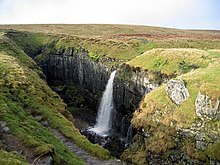Pen-y-ghent
| Pen-y-ghent | |
|---|---|
Cumbric | |
| Pronunciation | /ˈpɛnɪɡɛnt/ |
| Geography | |
Location of Pen-y-ghent in the Yorkshire Dales National Park | |
| Location | Yorkshire Dales, England |
| OS grid | SD838733 |
| Topo map | OS Landranger 98 |
Pen-y-ghent or Penyghent is a fell in the Yorkshire Dales, England. It is the lowest of Yorkshire's Three Peaks at 2,277 feet (694 m);[1] the other two being Ingleborough and Whernside.[2] It lies 1.9 miles (3 km) east of Horton in Ribblesdale.[3] It has a number of interesting geological features, such as Hunt Pot, and further down, Hull Pot. The waters that flow in have created an extensive cave system which rises at Brants Gill head.
In 2004 the body of Lamduan Armitage, dubbed by the media the "Lady of the Hills", was found near to the entrance of Sell Gill Hole.[4]
Etymology
In the
It is also acceptable to write the name as Pen y Ghent rather than Pen-y-ghent.
Geography

Pen-y-Ghent is made up of a millstone grit top upon a bed of carboniferous limestone.
Hull Pot Beck rises on the western side of Plover Hill and flows into Hull Pot, which is the largest natural hole in England.[10] Hull Pot measures 300 feet (91 m) long by 60 feet (18 m) wide and 60 feet (18 m) deep.[11] The water then flows under Horton Moor before re-appearing just east of Horton in Ribblesdale as Brants Ghyll Beck, where it flows into the River Ribble.[12] Local legend has it that the waters from Hull Pot and Hunt Pot cross each other underground without mixing. This is said to have first been noted when a sheep wash was undertaken in one stream thereby making it muddy, and the husks of oats being dropped into the other stream and both having exited into the Ribble without mixing together.[13]
Hiking
The
Pen-y-ghent is one of the mountains on the Yorkshire Three Peaks route.[14]
References
- ^ a b "Picture Post: More snow forecast for Pen Y Ghent". The Yorkshire Post. 24 January 2016. Retrieved 29 May 2017.
- ^ Fletcher, Terry (17 May 2017). "Yorkshire Dales walk - Pen-Y-Ghent and Plover Hill". yorkshirelife.co.uk. Retrieved 29 May 2017.
- ^ ISBN 9780319263310.
- ^ "'Mail order bride' theory in body mystery". BBC News. 30 October 2018. Retrieved 25 November 2018.
- ISBN 9780711228252.
- ISBN 0-19-869103-3.
- ^ James, Alan G. "A Guide to the Place-Name Evidence - Guide to the Elements" (PDF). Scottish Place Name Society - The common Brittonic Language in the Old North. Retrieved 25 October 2018.
- ^ "BBC - Seven Wonders - Three Peaks". www.bbc.co.uk. Retrieved 29 May 2017.
- ^ a b "Pen-y-ghent". yorkshiredales.org.uk. Retrieved 29 May 2017.
- ^ "Weekend Walk: Hull Pot". The Yorkshire Post. 14 January 2017. Retrieved 29 May 2017.
- ^ a b "Walk 33; Pen-y-ghent from Horton" (PDF). nationaltrail.co.uk. Retrieved 29 May 2017.
- ^ "Brantsghyll Beck". Environment Agency. Retrieved 29 May 2017.
- OCLC 650329471.
- ^ "Yorkshire Three Peaks Challenge". National Three Peaks Challenge. Retrieved 17 October 2018.
Bibliography
- Bibby, Andrew (2008), The Backbone of England, London: Francis Lincoln Limited
- Ekwall, Eilert (1960), The Concise Oxford Dictionary of English Place-Names, 4th ed., Oxford: Oxford University Press
External links
- Computer generated summit panoramas Pen-y-ghent index
- Photos of Pen-y-ghent and surrounding area on geograph.org.uk
- Climb Pen-y-ghent from Horton-in-Ribblesdale


